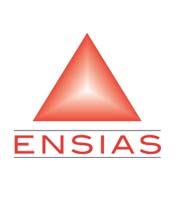- Accueil
-
L'Ecole
-
FORMATIONS
-
FORMATION INGENIEUR
-
Nouvelles filières offertes
- Ingénierie Intélligence Artificielle (2IA)
- Smart Supply Chain & Logistics (2SCL)
- Business Intelligence & Analytics (BI&A)
- Génie de la Data (GD)
- Génie Logiciel (GL)
- Ingénierie Digitale pour la Finance (IDF)
- Smart System Engineering (SSE)
- Data and Software Sciences (D2S)
- Cybersécurité, Cloud et Informatique Mobile (CSCC)
- REGLEMENT DES ETUDES DE L’ENSIAS CYCLE INGENIEUR
-
Nouvelles filières offertes
-
FORMATION INGENIEUR
- FORMATION CONTINUE
-
Recherche
- INTERNATIONAL
- ENTREPRISES
- VIE ESTUDIANTINE
- BIBLIOTHEQUE
LES DERNIÈRES INFORMATIONS
Internet-of-Things Based Hardware-in-the-Loop Framework for Model-Predictive-Control of Smart Building Ventilation
| Titre | Internet-of-Things Based Hardware-in-the-Loop Framework for Model-Predictive-Control of Smart Building Ventilation |
| Publication Type | Journal Article |
| Year of Publication | 2022 |
| Authors | Kharbouch, A, Berouine, A, Elkhoukhi, H, Berrabah, S, Bakhouya, M, D. Ouadghiri, E, Gaber, J |
| Journal | Sensors |
| Volume | 22 |
| Mots-clés | Air conditioning, Air pollution, Building ventilations, Carbon dioxide, Control approach, Control program, Data platform, energy efficiency, Energy utilization, Hardware in the loops, Hardware-in-the-loop simulation, Hardwarein-the-loop simulations (HIL), Indoor, Indoor air pollution, Internet of things, Learning algorithms, Long short-term memory, Machine learning algorithms, Machine-learning, MATLAB, Model predictive control, Model-predictive control, Predictive control, procedures, Simulation platform, Synthetic apertures, Ventilation |
| Abstract | In this work, a Hardware-In-the-Loop (HIL) framework is introduced for the implementation and the assessment of predictive control approaches in smart buildings. The framework combines recent Internet of Things (IoT) and big data platforms together with machine-learning algorithms and MATLAB-based Model Predictive Control (MPC) programs in order to enable HIL simulations. As a case study, the MPC algorithm was deployed for control of a standalone ventilation system (VS). The objective is to maintain the indoor Carbon Dioxide (CO2) concentration at the standard comfort range while enhancing energy efficiency in the building. The proposed framework has been tested and deployed in a real-case scenario of the EEBLab test site. The MPC controller has been implemented on MATLAB/Simulink and deployed in a Raspberry Pi (RPi) hardware. Contextual data are collected using the deployed IoT/big data platform and injected into the MPC and LSTM machine learning models. Occupants’ numbers were first forecasted and then sent to the MPC to predict the optimal ventilation flow rates. The performance of the MPC control over the HIL framework has been assessed and compared to an ON/OFF strategy. Results show the usefulness of the proposed approach and its effectiveness in reducing energy consumption by approximately 16%, while maintaining good indoor air quality. © 2022 by the authors. |
| URL | https://www.scopus.com/inward/record.uri?eid=2-s2.0-85140844555&doi=10.3390%2fs22207978&partnerID=40&md5=85b1a27cdc872a2b2f27b188c17282c8 |
| DOI | 10.3390/s22207978 |
Revues:
LIENS UTILES
Localisation
Contactez-nous
ENSIAS
 Avenue Mohammed Ben Abdallah Regragui, Madinat Al Irfane, BP 713, Agdal Rabat, Maroc
Avenue Mohammed Ben Abdallah Regragui, Madinat Al Irfane, BP 713, Agdal Rabat, Maroc
![]() Télécopie : (+212) 5 37 68 60 78
Télécopie : (+212) 5 37 68 60 78
![]() Secrétariat de direction : 06 61 48 10 97
Secrétariat de direction : 06 61 48 10 97
Secrétariat général : 06 61 34 09 27
Service des affaires financières : 06 61 44 76 79
Service des affaires estudiantines : 06 62 77 10 17 / n.mhirich@um5s.net.ma
CEDOC ST2I : 06 66 39 75 16
Résidences : 06 61 82 89 77
- Compteur de visiteurs:634,776
Education - This is a contributing Drupal Theme
Design by WeebPal.
Design by WeebPal.



































